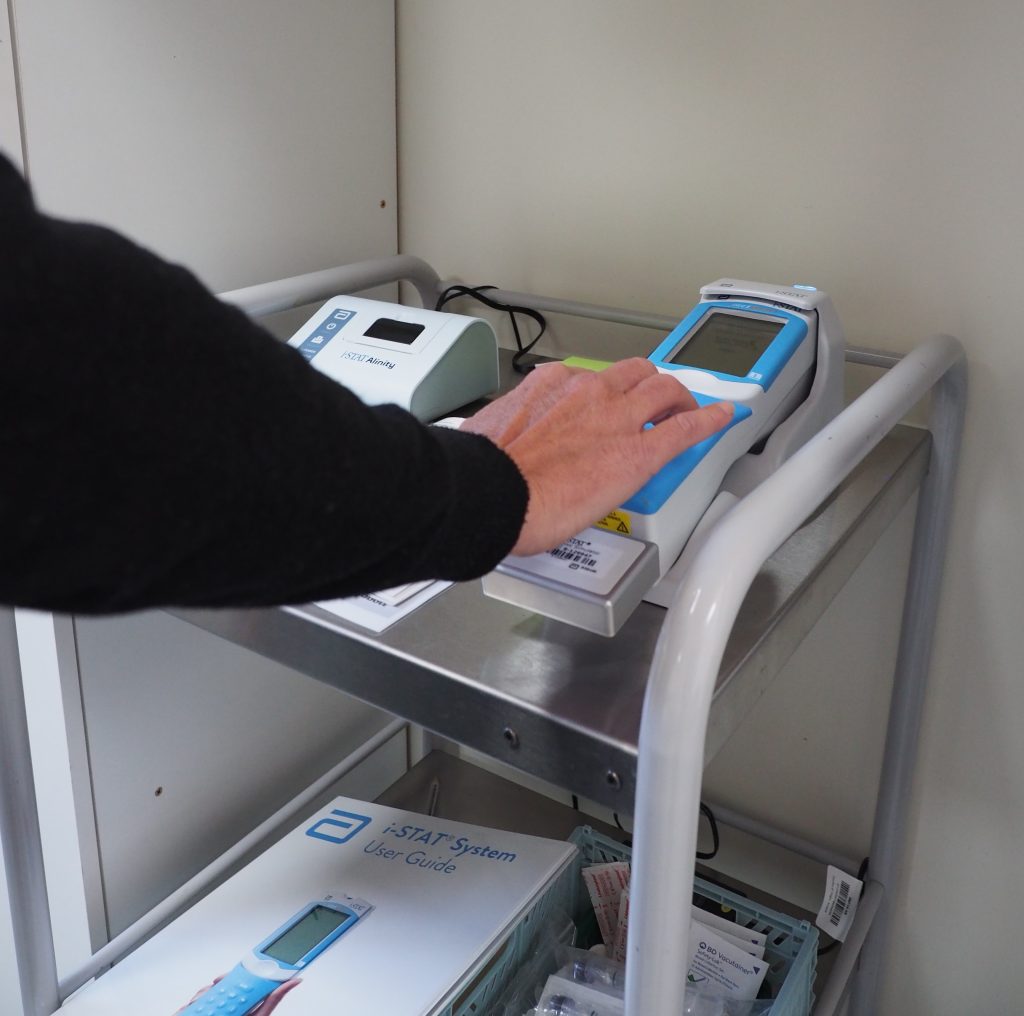i-STAT machine places community at the heart of local health care
Posted on October 6, 2023

An i-STAT machine is a point-of-care blood testing device designed to deliver rapid results for a range of critical care tests, and can be invaluable when assessing the cardiac condition of someone presenting with chest pain.
The introduction of i-STAT testing at the Tasman Multi-Purpose Service at Nubeena has the potential to save lives locally, and will also help prevent patients being transported to Hobart unnecessarily.
Primary Health Tasmania, Health Consumers Tasmania and the Tasmanian Health Service have been working with the Tasman community to identify and address local health and wellbeing needs, challenges and opportunities.
One of the recommendations identified in the community engagement and consultation process driven by Primary Health Tasmania was that an i-STAT machine would be beneficial for a number of uses, particularly testing troponin levels when assessing and triaging chest pain.
An i-STAT test can help quickly determine whether a person – either someone admitted to the Tasman Multi-Purpose Service, or a person who presents to the general practice – can be managed locally or requires transfer to Hobart for specialist care.
The machine has now been purchased by the Tasmanian Health Service with funding from the Tasmanian Department of Health and delivered to the Multi-Purpose Service, where staff have been trained to use the potentially life-saving device.
Tasmanian Health Service Nursing Director (subacute, aged and community services) Bruce Edwards says if a patient in the Multi-Purpose Service is getting more and more unwell, sometimes you don’t want to wait 12 to 24 hours to get the blood test results from the laboratory so the doctor can make decisions regarding treatment and ongoing care.
“Certain blood tests can be undertaken using the new i-STAT machine,” Bruce says. “These tests can be undertaken quickly at the point of care and, depending on the results, assist the doctor in the decision to continue managing a patient locally.
“In the absence of access to point-of-care blood tests the doctor, based on the patient’s clinical picture, can either take a blood test and wait for the results, with risk of clinical deterioration; or take a conservative approach by transferring the patient in an ambulance to the Royal Hobart Hospital for specialist review and treatment. In some cases, this may lead to unnecessary transfers.
“It’s all about improving care, but also about reducing unnecessary patient transfers to Hobart.”
Bruce says the i-STAT point-of-care testing is an extra tool to help doctors make a clinical decision.
“Some blood test results being available faster means earlier intervention,” he says. “Access to earlier blood results also allows the local doctor to seek advice and support from specialist doctors sooner.
“It’s great for patients, but also for the doctors and nursing staff.”
Bruce is also chair of the Tasman Clinical Services Action Group, which works to implement the initiatives and activities identified as community needs.
“We had Health Consumers Tasmania come and do the community consultation, which led to the eventual establishment of their advisory group, the Tasman Voice for Health,” he says.
“Part of that process was the establishment also of the clinical action group, which is made up of a whole range of service providers on the Tasman Peninsula.”
This includes Huon Regional Care (operator of the Tasman Multi-Purpose Service), local GPs and pharmacist, the Royal Flying Doctor Service, Ambulance Tasmania, headspace, and Primary Health Tasmania and the Tasmanian Health Service as service funders.
“The Tasman Voice for Health provides advice to the clinical action group on those health services that are a priority to the local community.”
Huon Regional Care Tasman facility manager Leeanne Triffitt is also a member of the Tasman Clinical Services Action Group, and says the i-STAT machine was approved and delivered soon after it was discussed at a meeting of key industry and community stakeholders.
Leeanne sees the potential for the machine to save local lives, and also help alleviate bed block at the Royal Hobart Hospital.
“It’s a great idea, and is certainly going to save a lot of unnecessary admissions through Emergency,” she says.
“If we suspect someone of having had a cardiac event our usual process is to send them through to Hobart, so they’re probably looking at a two-hour gap before actually getting into emergency care.
“There’s a mindset down here that Hobart is a million miles away. People tend to ignore symptoms and think ‘I’ll be alright’ because they don’t want to call an ambulance and go to Hobart.
“If they knew there was an option for them to get checked out here, they might come in here instead of doing nothing.”
Leeanne says her team is looking forward to working with local service providers and authorities to offer i-STAT testing to the community on an ongoing basis.
“My staff were really keen, we had a good turnout of people who wanted to learn how to use the machine,” she says.
“We’re really interested in doing things that are new here.
“The staff work really hard to do their training and be capable of providing the services needed to keep people here in the community, rather than having to drive to Hobart.”
Primary Health Tasmania’s Martina Wyss says this is a great example of how a robust consultation process can quickly lead to results.
“Together, we were able to agree on a priority need, come up with an idea to address it, and make it happen.
“For a relatively small investment the results are likely to be fewer hospital admissions and better health for the Tasman community.”
Want to know more about our work with the Tasman community? Click here
Click here to download a PDF of this story.
